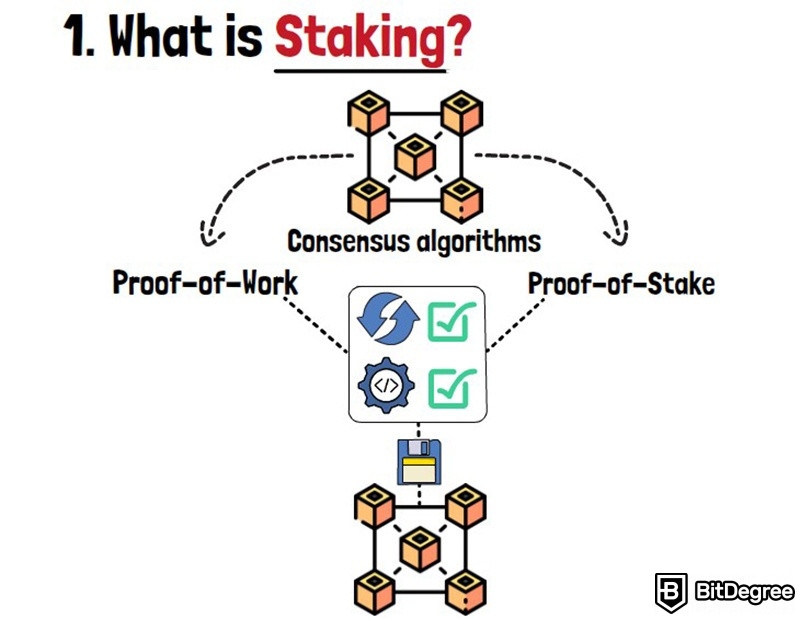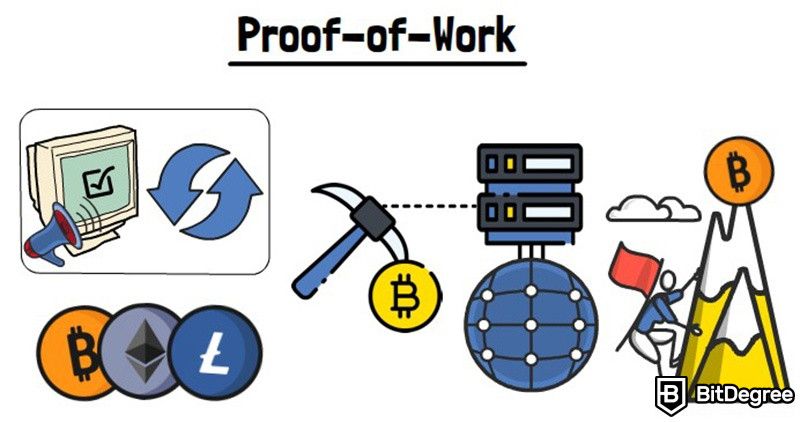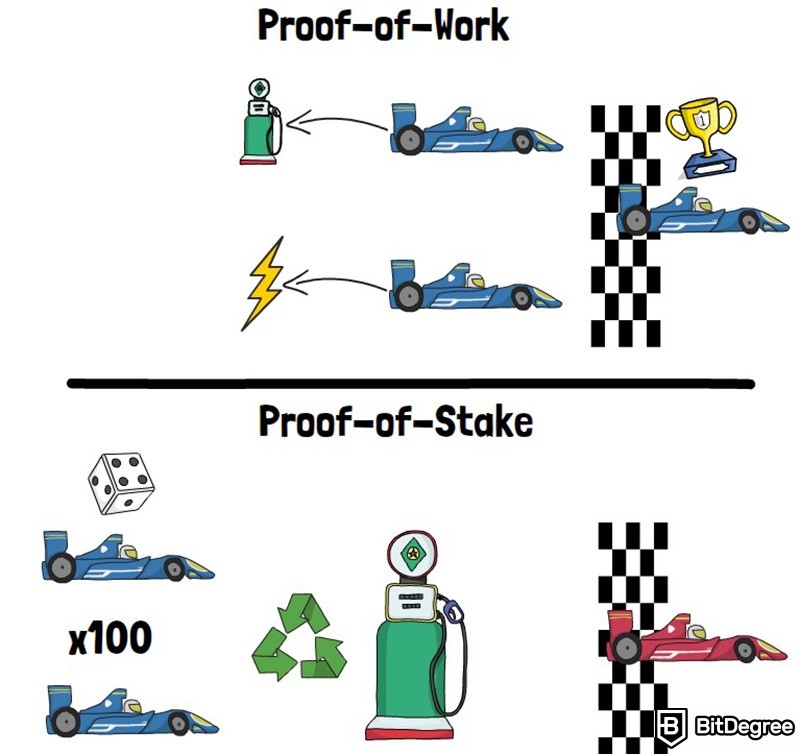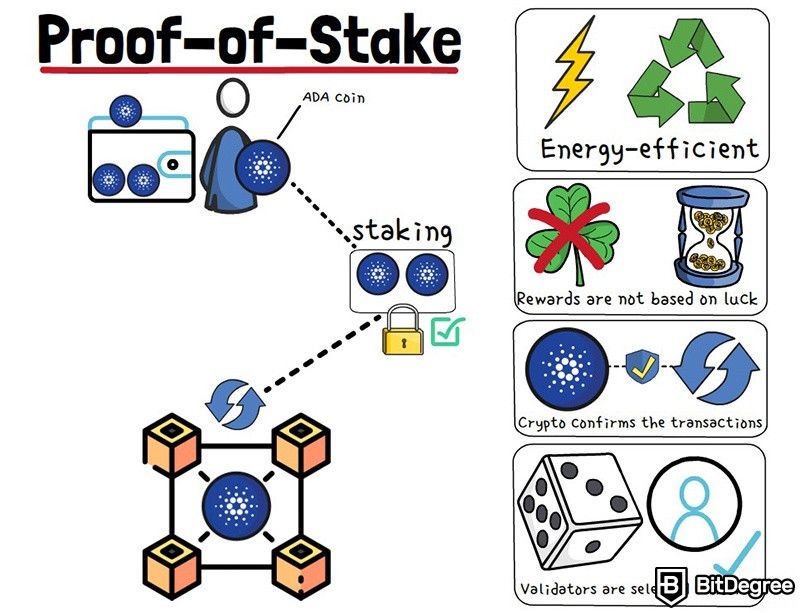What is the Goal of Staking Crypto Assets?
In this section, I will tell you what is staking in crypto!
I bet you’ve heard the term “staking” before, multiple times, even. It’s a word that keeps popping up on various cryptocurrency exchange platforms, wallet interfaces, and so on. Now, have you ever thought - “what in the world does this word mean?!”? Well, that is EXACTLY what I will tell you about, in this section!
In this section, we’re going to answer what is “staking” in crypto. Specifically, we’ll examine what this term ACTUALLY means, talk about the concepts of Proof-of-Work and Proof-of-Stake, and take a look at some of the risks associated with the process, too!
Let’s get to it!

Video Explainer
Video Explainer: What is the Goal of Staking Crypto Assets?
Reading is not your thing? Watch the "What is the Goal of Staking Crypto Assets?" video explainer
What Does Staking Mean in Crypto? (Easily Explained!)


What is Staking?
So, then - what in the world is “staking”?
Well, in order to truly understand staking, you will need to be aware of concepts known as “Proof-of-Work” and “Proof-of-Stake”.
I’ve discussed these terms in a section about blockchains. If you’d like to learn more about it, and understand the topic in-depth, I’d highly advise you to go check that section out, and then come back to this one.
With that out of the way, allow me to give you a brief run down.
In the world of crypto, there are two main ways how blockchains function - those ways are called “Proof-of-Work” and “Proof-of-Stake”. Both of these concepts are called “consensus algorithms” - in human-speak, this refers to the methods of how blockchains verify the transactions (or, simply, processes) happening on them in order to save those transactions into the blockchain. So, when you buy or sell cryptocurrency, this is a transaction, and it needs to be checked & confirmed!

Proof-of-Work is the oldest and best-known transaction verification process. It’s used with Bitcoin, Ethereum 1.0, and many other popular cryptocurrencies. With PoW, you have miners - special computers and crypto machines that are plugged into the network, and are constantly competing for their chance to earn cryptocurrency.
Being the oldest form of transaction confirmations, PoW is often seen as the worst option, as well. Even though it’s used by a huge number of cryptocurrencies out there, most new and emerging coins are switching to the second, opposite one - the Proof-of-Stake concept.

The way you can look at both concepts of transaction verification is like this - imagine that there are two car race events happening in your town. In the Proof of Work racing event, all of the cars race to the finish line - however, only one of the cars wins the race! So, all of the other cars basically wasted fuel and energy.
As opposed to that, in the Proof-of-Stake racing event, out of all the cars near the starting line, only one, let's say randomly, is selected to drive in the race. Thus, if there are, say, 100 different cars near the starting line, that’s a huge amount of fuel saved!
With Proof-of-Work, all miners compete to verify transactions happening on the blockchain, but only one, in most cases the biggest and most powerful one, wins and receives a reward. On the flip side, with Proof-of-Stake, only a single miner (well, here, it’s actually called a validator) is chosen, and he needs to verify the transaction. And after that, let’s say, a few extra validators are needed to check his final result. It’s much more energy-efficient!

Now, this is where we get into the “staking” part of the section.
As I’ve mentioned earlier, with PoW, transactions are confirmed with miners. These miners are special machines used to mine cryptocurrency. They are usually very expensive, consume astonishing amounts of electricity, and are bad for the environment.
In regards to PoS, there are no expensive machines to do the work. Well, at least none that you’d need to buy. Machines do exist, but you “mine” by staking your coins, and not turning on a special mining rig. In other words, transactions are confirmed by staking your existing cryptocurrency!

Let’s illustrate this with an example. Let’s take, say, the ADA coin, also known as Cardano. It’s one of the most popular cryptocurrencies that uses a PoS consensus algorithm.
If you want to become one of the people who confirm transactions on the ADA network, you don’t need to buy an expensive “ADA miner” - such machines do not exist. Instead, all that you need to have is some ADA cryptocurrency. Then, in a random order, validators are selected, and rewarded for legitimate transaction confirmations - this is as opposed to PoW, where everyone participates in the “race”.
You will be confirming the transactions with your ADA coins - in a way, this acts as a casino. You stake your coins, and if the transaction is legitimate, you will receive rewards. If it’s not, you will lose all of your staked coins.
Unlike a casino, though, your chances of “winning” aren’t based on luck. Instead, they are purely up to you - if there are malicious individuals trying to push a fraudulent transaction, they will be punished by losing all of their staked coins - this incentivizes the validators to remain fair, and avoid foul play.
Remember the car race example I gave a bit earlier? Well, you might say - why would other cars go to the starting line, if only one car will actually drive in the race?
Well, other cars - or, as it relates to our topic, other validators - are there to ensure that the chosen car does a good job, and actually finishes the race. When you stake your cryptocurrency, and validate a transaction, other validators are going to check whether or not you’ve done so successfully. If that’s the case, you get rewarded - if not, you get penalized, and your coins get taken away from you.
As you can see, in a very general sense, the process is actually quite simple - it’s like you playing a multiple-choice guessing game, where your goal is to increase the value of your pot. The entire process described here is a representation of Proof-of-Stake, and showcases how blockchains confirm transactions in a fast, efficient, and energy-preserving way.
One last point to discuss before moving on is the validator selection process. In other words, when all of the cars align at the starting line, and get ready to race, how is the single car that’ll participate in the race chosen?
Well, there are three major criteria for choosing the one validator that’ll confirm a transaction - age, amount of coins, and a randomness-ensuring factor.
The first two are self-explanatory - if you hold a huge amount of coins, and are staking them for a long time already, the network recognizes that you’re probably legitimate, and prioritizes picking you as the validator. However, in order to avoid a monopoly of large staking companies taking control of the entire blockchain infrastructure, there’s a random number picker inserted into the selection process, as well.
In other words, even if you don’t hold a lot of coins, and have just started staking crypto, there is a chance that you’ll get picked as the validator, as well.
An Alternative Look at Staking
Up to this point in time, we’ve discussed staking from a very technical point of view - PoW, PoS, validators, transactions, and so on. I’d like to remind you that, if you want to learn more about each of these topics, make sure to go through the "Bitdegree Crypto 101 Handbook", you’ll find sections on all of the important topics that might interest you!
Moving on, though, I would now like to tell you about an alternative way that you can look at staking - one that’s much simpler and more user-friendly than all of the technical stuff we’ve discussed up to this point.
Staking allows blockchains to confirm transactions - that’s true. However, nowadays, the term can be seen on a huge variety of cryptocurrency exchanges, wallets, and other services. You might even notice terms such as “liquidity pool” being mentioned, as well.

All of that is because staking allows you - the simple user - to earn rewards in almost the same way as original big Proof-of-Stake validators, but without setting up and owning machines or solving software and connection issues!
For us, small or medium crypto holders - staking is a good chance to earn extra with cryptocurrencies that we have decided to hold and not to trade for a specific period of time. Imagine, you have decided to earn from your Bitcoins that you have just bought, just by holding them for 10 years, you’re not a day trader, but a long-term crypto “hodler” with no speculative intentions or even knowledge.
In this situation, with staking pool services, you’ll be able to earn the same way, by just holding your Bitcoins and not selling them for 10 years, predicting that the value of Bitcoin will grow, and as an extra, by “lending” those same Bitcoins to the staking pool and earning.
Specifically, while you stake your crypto coins on exchange pools, you are able to earn a passive interest. It’s like trusting your money with a friend, for a specified amount of time, and then getting back more than you’ve given.
The concept is very popular among smaller or medium crypto enthusiasts, since it involves earning more cryptocurrency, without actually doing anything. You just delegate your coins to an exchanges’ staking pool for a specific period - it may look complicated, but with many exchanges or wallets, all that you need to do is to click a single button, and wait. That’s it!
All other technical parts of the validation process are covered by exchanges or staking pool owners themselves. By attracting your extra funds, exchanges make their staking pool bigger, they get chosen to validate transactions more frequently, and because of a higher probability to be chosen, they earn more, and finally, they share the revenue from these validations with you.
Staking Risks
Now, I don’t want to alarm you, but you should be aware of the fact that there are risks associated with staking, too. Just like in the earlier-mentioned casino example, you might end up with more crypto than you’ve initially started with, or lose everything.
That’s the biggest risk, actually - if you or a staking pool confirm a faulty transaction, you are at risk of losing all of your staked coins. This is why it is very important to choose the verified and well-known staking pool as a service provider. However, while this is the most commonly-referenced risk, there are other things to be aware of when deciding on whether or not you should start staking your crypto!

For example, the process is still rather technical. If you plan to stake simply in order to earn interest, on an exchange platform, things are going to be simple - most exchanges and wallets have guides on how to do so.
However, if you want to become an actual validator of a network on your own, you’ll need to delve deeper into the topics of blockchains, Proof-of-Stake, and hardware stuff.
Furthermore, while staking your coins, you will need to lock them up for a period of time. Meaning that you won’t be able to withdraw or trade them! The time periods will differ depending on a few different criteria, but if you’re an active day trader, this might pose an issue.
The topic of staking (and Proof-of-Stake) can be difficult and complicated, but in this section, we’ve covered all of the core aspects, in simple terms. That being said, I hope that the concept is understandable for you now.










